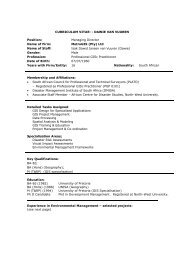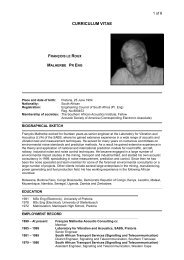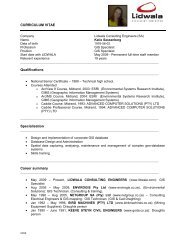environmental impact assessment - Lidwala Consulting Engineers
environmental impact assessment - Lidwala Consulting Engineers
environmental impact assessment - Lidwala Consulting Engineers
Create successful ePaper yourself
Turn your PDF publications into a flip-book with our unique Google optimized e-Paper software.
ENVIRONMENTAL IMPACT ASSESSMENT (EIA)FOR THE PROPOSED 1X400KV TABOR-BOKMAKIRIE (NZHELELE)AND 4 X 250MVA 400KV/132KV NZHELELE MAIN TRANSMISSIONSTATION (MTS), LIMPOPO PROVINCEDEA REFERENCE NUMBER:14/12/16/3/3/2/317BACKGROUND INFORMATION DOCUMENTMay 2012INTRODUCTIONEskom Holdings (SOC) Limited plans to construct a 100km 400kV powerline between theTabor and Bokmakirie (Nzhelele) Substations in the Limpopo Province.<strong>Lidwala</strong> <strong>Consulting</strong> <strong>Engineers</strong> (SA)(Pty) Ltd has been appointed as the independent<strong>environmental</strong> <strong>assessment</strong> practitioner (EAP) to undertake the Scoping andEnvironmental Impact Assessment (EIA) for the proposed project. The EIA will conformto the Environmental Impact Assessment Regulations published in Government NoticesR543 to R546 of 18 June 2010 in terms of Section 24 (5) of the National EnvironmentalManagement Act (Act No. 107 of 1998).WHAT DOES THIS DOCUMENT TELL YOU?The purpose of this Background Information Document (BID) is to provide interested andaffected parties (I&APs) with background information about the proposed project and theEIA process to be undertaken. It also explains how you can become involved in theproject, receive further information as the EIA progresses, and raise issues regarding thepotential <strong>impact</strong>s of the project on the environment. You are therefore invited toregister as an I&AP using the attached comments and registration sheet.This BID document will help I&APs to:• Determine if they are interested in and/or affected by the proposed project;• Better understand the project in order to be able to provide comment; and• Understand the <strong>environmental</strong> authorisation process so that they are able toparticipate effectively.WHY CONSTRUCT NEW TRANSMISSION LINES?The Eskom Conversion Act, 2001 (Act No. 13 of 2001) establishes Eskom Holdings (SOC)Limited (Eskom) as a State Owned Company (SOC) with the Government of South Africaas the only shareholder, represented by the Minister of Public Enterprises. The mainobjective of Eskom is to “provide energy and related services including the generation,transmission, distribution and supply of electricity, and to hold interests in otherentities”.1
Eskom is currently experiencing constraints in meeting its obligation to supply theprimary energy load requirements of South Africa. This load is expected to continuegrowing, placing increased strain on the supply of electricity. A number of new, coalfired power stations are being considered with two new, base load power stationsapproved to come on line between 2012 and 2016. However, these are not sufficient tomeet demand and additional power stations will be required. In line with Eskom's policyto diversify the fuel mix from the current high dependence on coal, as well as to reduceoverall emissions, other types of generation are under consideration.As part of its <strong>assessment</strong> of a range of electricity supply options, Eskom is investigatingthe feasibility of constructing a 400kV powerline between the abovementionedsubstations. An Environmental Impact Assessment (EIA) process for this proposedpowerline route and alternatives is currently being undertaken by <strong>Lidwala</strong> <strong>Consulting</strong><strong>Engineers</strong> (SA) (Pty) Ltd (DEA Reference number 14/12/16/3/3/2/317). Three (3) routealternatives have been identified to date for further investigation. The proposed layoutand best route will be determined through the <strong>environmental</strong> and specialist studies.WHAT DOES THE PROJECT ENTAIL?The proposed project entails the construction of 1x 400 kV Transmission Powerline fromthe Tabor Substation located just south of the Capricorn Toll Plaza approximately 67kmnorth of Polokwane to the proposed new Bokmakirie (Nzhelele) substation approximately45km south of Musina.Although the Bokmakirie Substation is not yet built, it has received an EnvironmentalAuthorisation for the building of a Distribution size substation for the new 132 kVpowerline that was recently established. This project will include the investigations andapplication for approval for the upgrading of the Bokmakirie substation to allow for theproposed new 400kV powerline.The full scope of work includes:• Establishment of 1 x 100km 400kV power line between Tabor and Bokmakirie(Nzhelele)• Expansion of Bokmakirie (Nzhelele) Substation with 4 X 250MVA 400KV/132KVtransformers and associated infrastructure, including:o Terrace the Nzhelele 400kV yard for and end-state of 4x 400kV feeder bays,o Terrace the Nzhelele 132kV yard for and end-state of 8x 132kV feeder bays,o Establish the control building, telecommunication infrastructure, oil dam,o Establish all the access road infrastructure to and within NzheleleWHERE IS THE PROPOSED DEVELOPMENT LOCATED?The preliminary alternative corridors for the proposed transmission lines are highlightedin Figure 1 below.2
Bokmakirie/ NzheleleSubstationTaborSubstationFigure 1: Proposed routes to be investigated for the Tabor-Nzhelele 400kVPowerline3
WHY AN EIA?An EIA is a legislative tool that is used to ensure that the potential <strong>impact</strong>s that mayoccur due to the proposed development are avoided or mitigated. In South Africanlegislation the environment includes social, economic and bio-physical aspects and theEIA must assess these equitably.In terms of the Environmental Impact Assessment Regulations published in GovernmentNotice R543 of 18 June 2010 in terms of Section 24 (5) of the National EnvironmentalManagement Act (Act No. 107 of 1998), certain listed activities as set out in GovernmentNotices R544, 545 and R546 require <strong>environmental</strong> authorisation before they canproceed. For the proposed ‘Tabor-Nzhelele 1x400kV powerline’ project the listedactivities are described in Box 1 below:Box 1: List of activitiesNO. R. 544 - LISTING NOTICE 1• Activity 10: The construction of facilities or infrastructure for the transmission anddistribution of electricity outside urban areas or industrial complexes with a capacity of morethan 33 but less than 275• Activity 23: The transformation of undeveloped, vacant or derelict land to (ii) residential,retail, commercial, recreational, industrial or institutional use, outside an urban area andwhere the total area to be transformed is bigger than 1 hectare but less that 20 hectares• Activity 38: The expansion of facilities for the transmission and distribution of electricitywhere the expanded capacity will exceed 275 kilovolts and the development footprint willincreaseNO. R. 545 - LISTING NOTICE 2• Activity 8: The construction of facilities or infrastructure for the transmission anddistribution of electricity with a capacity of 275 kilovolts or more, outside and urban area orindustrial complex• Activity 15: Physical alteration of undeveloped, vacant or derelict land for residential, retail,commercial, recreational, industrial or institutional use, where the total area to betransformed is 20 hectares or moreNO. R. 546 - LISTING NOTICE 3• Activity 3: The construction of masts or towers of any material used for telecommunicationbroadcasting or radio transmission purposes where the mast (a) is to be placed on a site notpreviously use for this purpose, and (b) will exceed 15 meters in height• Activity 4: The construction of a road wider than 4 meters with a reserve of less than 13.5meters4
WHAT DOES THE EIA PROCESS ENTAIL?The EIA can be divided into 4 distinct phases:Application and initial notificationDuring this phase an application for authorisation is made to the National Department ofEnvironmental Affairs (DEA). Once DEA acknowledges the EIA application (within 14days), an initial notification process takes place whereby the public is informed of theproposed development through inter alia, newspaper adverts, notification letters, BIDsand notice boards.Scoping phaseThe purpose of the scoping phase is:• To investigate and gather information on the proposed site in order to establish anunderstanding of the area;• To establish how the proposed development activities will potentially <strong>impact</strong> on thesurrounding environment;• To identify interested and affected parties (I&APs) and relevant authorities byconducting a Public Participation Process (PPP)• To identify potential <strong>environmental</strong> <strong>impact</strong>s through investigation and PPP; and• To describe and investigate the alternatives that may be considered.EIA phaseDuring this phase all issues and proposed alternatives identified in the scoping phase areassessed and rated in terms of their significance. Where necessary, mitigation measuresare recommended to reduce the significance of potential <strong>impact</strong>s. An EnvironmentalManagement Programme (EMPr) will also be compiled that will prescribe <strong>environmental</strong>specifications to be adhered to during the construction phase of the project. As with thescoping phase, PPP is an integral part of the <strong>assessment</strong> phase. Once the Final EIR hasbeen submitted to DEA, the decision making process will commence.Environmental AuthorisationAn Environmental Authorisation (EA) will be issued to Eskom once DEA has made adecision regarding the proposed development. This decision is based on inter alia,information received in the scoping and EIA phases.The EIA process is represented diagrammatically in Figure 2 on the following page:WHAT IS THE EIA PROGRAMME?The following preliminary programme is envisaged for the scoping and EIA:ApplicationPhaseScoping PhaseEIA PhaseDEA review anddecision-makingEnvironmentalAuthorisationApril 2012March to JulyJune toDecember 2012 toMarch 2012(Complete)2012December 2012February 20135
I&APs TASK DEA1NotificationsAdvertsNotice boards30 day comment periodSubmit application form toDEAAcknowledge receipt in 14daysConduct PPP, NotifyStakeholdersPrepare Draft Scoping Report(DSR)230 day comment periodSolicit comments on DSRSubmit final SR to DEAWithin 40 days acceptreport, or reject report orrequest amendments330 day comment periodPrepare draft EnvironmentalImpact Report (EIR) andEnvironmental ManagementProgramme (EMPr)Solicit comments on draft EIRSubmit final EIR/EMPr to DEAWithin 60 days acceptreport, or reject report orrequest amendments4Within 10 days adviseI&APs of EnvironmentalAuthorisationEnvironmental AuthorisationWithin 55 days ofacceptance, DEA must grantor refuse authorisation andinform applicant of thedecision1: Application and Initial Notification2: Scoping3: EIA4: Environmental AuthorisationFigure 2: EIA Process6
WHAT ARE THE POTENTIAL IMPACTS ASSOCIATED WITH THE DEVELOPMENT?Transmission lines may create a number of <strong>environmental</strong> <strong>impact</strong>s. A number ofpotential <strong>environmental</strong> issues have already been identified and are listed here to assistI&APs to better understand the investigations to be undertaken as part of the<strong>environmental</strong> <strong>assessment</strong> process. The preliminary list of <strong>environmental</strong> <strong>impact</strong>sincludes:BIOPHYSICALTYPE OF IMPACT & DESCRIPTIONPHASE OF DEVELOPMENTPotential <strong>impact</strong> Construction OperationalFauna and Flora including <strong>impact</strong>s toavifauna (Birds)Land capability and agricultural areasVisualWaste / Pollution X XSurface Water X XXXXXSOCIO-ECONOMICEconomic values of land and property X XImpacts on other existing infrastructure X XJob creation X XHealth <strong>impact</strong>s (Electromagnetic fields)SOCIO-CULTURALSense of place X XArchaeological andpalaeontological sitesHistorical sitesXXAll significant issues identified during scoping will be collated into a Comments andResponses Report and will be included in the Final Scoping Report.SpecialistsThe EIA project team will identify potential issues and assess these <strong>impact</strong>s in terms oftheir significance in accordance with the guidelines for EIA published by DEA. Specialiststudies will be conducted to assess the significance of all <strong>impact</strong>s identified. Thespecialist project team includes:SPECIALIST STUDY COMPANY PROPOSED SPECIALISTSSocial Impact Assessment <strong>Lidwala</strong> SA Frank van der KooyVisual Impact Study and GIS MetroGIS Dawie van VuurenBotanical Impact Assessment <strong>Lidwala</strong> SA Frank van der KooyBird Impact Assessment Endangered Wildlife Trust Andrew PearsonMammals, reptiles and amphibiansImpact AssessmentClayton CookHeritage Impact Assessment Private Consultant Johnny van SchlakwykImpact on land capability andagricultural areasAgricultural Research Council Garry PattersonThe exact scope and number of specialist studies can only be confirmed upon completionof the scoping phase, once issues have been identified by the public.7
AUTHORISING AUTHORITYAs Eskom is a State Owned Company, authorisation has to be granted by the NationalDEA in consultation with the provincial <strong>environmental</strong> authorities. An <strong>environmental</strong>authorisation will be issued by DEA based on the information provided in the FinalScoping Report, the Final Environmental Impact Report and the EnvironmentalManagement Plan.WHAT IS PUBLIC PARTICIPATION?Public participation (PP) is a joint effort between stakeholders, the proponent, technicalspecialists and decision-makers who work together to produce better decisions than theywould have done had they acted independently. The public participation process (PPP)aims to inform a wide range of I&APs about the proposed project and the <strong>environmental</strong><strong>impact</strong> <strong>assessment</strong> process. It is a tool to allow the public to exchange information andexpress their views and concerns about the proposed development. Scoping facilitatesthe identification of issues and concerns early in the EIA process and thus ensures thatthey are incorporated into the project planning to assist in the selection of optimumroutes for the proposed powerlines. All contributions from I&APs will be fullydocumented, evaluated and responded to in the EIA.The public participation process (PPP) provides opportunities for I&APs to be involvedright from the outset of the EIA. The PPP includes the following steps to ensure effectivepublic participation:STEP 1: Register I&APs and key stakeholders on the database (on-going)STEP 2: Advertise the EIA process and availability of the BID (local and regional press)STEP 3: Consultation with and dissemination of information to I&APs through the BID,one-on-one consultation, public meetings, public open days, focus groupmeetings and key stakeholder workshops during the scoping and EIA phasesSTEP 4: Invite I&AP comment and input on the draft scoping and EIA reports (30-daycomment period)STEP 5: Record all comments, issues and concerns raised by I&APs in an Issues andResponse Report for inclusion in the final scoping and EIA reportsGETTING INVOLVEDYou can get involved in the EIA by:• Providing your contact details to the public participation office using the detailsprovided below;• Registering as an I&AP using the attached Comments and Registration Sheet andreturning it to the public participation consultant by post, fax or email using thedetails provided below;• Examining the information provided in this Background Information Document oron the website (www.eskom.co.za/eia) and completing the attached Commentsand Registration Sheet and returning it to the public participation consultant bypost, fax or email using the details provided below;8
• Attending the meetings that will be held during the EIA so that you can obtainfurther information, interact with the project team members and raise issues andconcerns. Should you register as an I&AP you will be invited to attend thesemeetings. Details of the meetings will also be advertised in local and regionalnewspapers;• Contacting the public participation consultant by phone, post, fax or email shouldyou have a query, wish to make a comment or require further information; and• Reviewing and commenting on the draft Scoping and Environmental Impact reportswithin the 30-day review periods provided.If you register as an I&AP you will automatically receive any further information that isdistributed as part of this EIA and be invited to public meetings. Should you wish tocomment on the draft reports that will be made available for public review it is importantthat you take note of the 30-day review period and the deadlines for submission ofcomments. Comments can be submitted in writing via post, fax or email, using either theComment Sheets provided or your own format, to <strong>Lidwala</strong> <strong>Consulting</strong> <strong>Engineers</strong>(SA)(Pty) Ltd using the contact details below.PUBLIC PARTICIPATION OFFICE CONTACT DETAILS<strong>Lidwala</strong> <strong>Consulting</strong> <strong>Engineers</strong> (SA)(Pty) LtdP.O. Box 32497, Waverley, 0135Email: bmhlanga@lidwala.comFax: 086 675 1103 Telephone: 0861 543 92529







